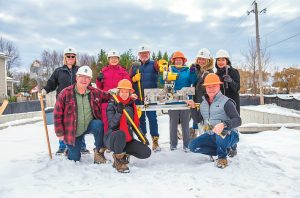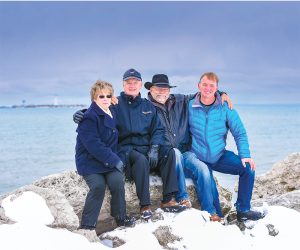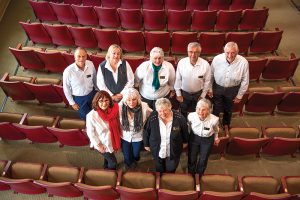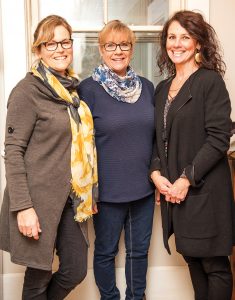6 groups that make a difference in our community
stories by Emily Worts & Janet Lees
photography by Doug Burlock
People are the foundation of the lifestyle that makes Southern Georgian Bay so special, and we can lay claim to having some of the best within our midst. In each community, small groups of people quietly but persistently go about making a positive impact. In many cases, no one person can be singled out – it is a team effort.
On The Bay honours six local groups made up of extraordinary people from all walks of life who have banded together to make a difference that will be felt for years to come. We should be proud to call them our neighbours and friends.
Nominate a Grassroots Heroes group!
Habitat for Humanity
“Habitat is a hand up, not a hand out,” says Andrew Turnbull, chair of Habitat for Humanity South Georgian Bay, quoting the organization’s motto. “It’s critical to understand this. Habitat helps low-income families build and buy decent quality homes, but not for free.”
Habitat for Humanity South Georgian Bay is a non-profit, non-denominational housing organization that works in partnership with low-income families to build affordable homes. “It’s not like winning the lottery,” explains Turnbull. “The people who are chosen have already done a lot of things right, but no matter how hard they work they are still faced with the reality of not being able to afford their own home.”
The Habitat model not only provides housing for families in need, it helps families build assets and reduce their dependence on social assistance, offering children much-needed stability while breaking the cycle of poverty. “Often people are paying far too high a percentage of their income toward rent and they’re living in sub-standard environments,” says Turnbull. “It compounds things. The parents are working flat out with very little money left over for things beyond necessities.”
To make Habitat building possible, the organization relies on a plethora of volunteers, nine of whom sit on the board of directors. Turnbull, a hotelier, joins eight others at the boardroom table, including people with experience in finance and human resources, an educator, a minister, and social media and marketing experts.
“Everybody is attracted to the organization because of some relationship they have, perhaps in their own upbringing,” says Turnbull. “Regardless, everybody has a window into the importance of a safe and stable home environment and can imagine how instability has an impact.”
Sitting on the Board of Habitat is a commitment. Members meet weekly for two hours, 10 months of the year. In addition, time is volunteered on specific committees, coordinating volunteers, swinging a hammer or serving a hot lunch at the Habitat build sites, or working in the retail arm of Habitat for Humanity, the ReStore (100 per cent of all administrative and fundraising costs are paid for by the operation of the ReStore).
But this commitment is paying off. Habitat for Humanity South Georgian Bay is in the process of completing its 15th and 16th builds since its inception in 2000.
“On average there are two children per family. When you think of it, that’s a whole classroom worth of children whose lives have been dramatically altered for the better,” says Turnbull of the 16 families who have safe and comfortable homes because of Habitat.
And thanks to the hard work of the board and the many volunteers, for the first time in its history, Habitat South Georgian Bay has land “in the bank,” with room to build four new homes for four new families from Southern Georgian Bay.
For more information, visit habitatgeorgianbay.ca
Nottawasaga Lighthouse Preservation Society
On November 30, 2018, the Nottawasaga Lighthouse briefly shone across the waters of Georgian Bay once again, celebrating the 160th anniversary since it began serving as a beacon for ships navigating the treacherous shoals and shallow waters that guard the entrance to Collingwood Harbour.
The lighting of the 85-foot tower also marked a turning point for the lighthouse. After decades of grassroots efforts to save the historic local icon, the Nottawasaga Lighthouse
Preservation Society (NLPS) is now in the final stages of securing ownership of the lighthouse and surrounding island from the federal government.
“We see it as a really good opportunity to celebrate our marine heritage and create a strong tourism destination point for people to experience first-hand,” says NLPS director Rick Crouch.
“If we can bring the lantern back to life, that’s just a bonus.”
While it’s not yet clear whether it will be possible to re-light the lantern permanently, the NLPS has big plans for restoring the lighthouse to its former glory. Today the tower looks good from a distance, but beneath the protective ‘wrap’ the NLPS applied in 2016 – at a cost of $100,000 – it is in a state of crumbling disrepair. In addition to general weather damage and neglect, the tower was hit by lightning in 2004, causing a large portion of the outer wall to sheer off.
“It’s structurally sound, and it’s protected from further damage, but we need to completely strip off the 160-year-old external stonework and replace it,” says Crouch. Plans also include restoring the interior of the lighthouse, including the lantern room itself, and rebuilding the lighthouse keeper’s house (the original burned down in the 1950s).
Using modern but heritage-correct materials and possibly some items repurposed from other lighthouses, the cost for the restoration would be about $2 to $2.5 million, not including in-kind donations of materials and labour, says Crouch.
The ultimate vision would see tourists being ferried to Nottawasaga Island by boat to explore the lighthouse and keeper’s house. “People will be able to tour the lighthouse, climb to the top, look out at the views and imagine what it was like back in the day to manage and operate these facilities, and to see first-hand the role that the lighthouse played in Collingwood developing itself as both a major shipbuilding centre as well as a shipping point,” says Crouch. “There’s tremendous value to that.”
Once the NLPS has obtained ownership, the plan will be finalized and will likely be implemented in stages, he adds.
“The closer we get, the more excited we get, knowing we’re inching closer and closer to getting ownership, which will allow us to kick off a more formal and higher-level fundraising plan,” says Crouch, adding, “We do this because we see the importance of it and we want to be active in preserving our heritage.”
For more information, visit nlps.info
Rotary Club of Wasaga Beach & Area
Though the Wasaga Beach Rotary Club membership is modest, it is mighty. “Service above self, it’s simple,” says Kevin de Groot, president of the Rotary Club of Wasaga Beach & Area. And that’s what it takes to raise almost $100,000 annually with just 26 active members.
More than a dozen local charities, schools and clubs are recipients of the annual fundraising efforts of the club. And every year, one lucky Wasaga Beach high school graduate pursuing a college or university education is awarded $1,000 by the club. On top of handing out much-needed funds, the club also packs and distributes over 250 Easter hampers every spring with the help of the local food bank.
“Over 95 per cent of money raised by the club stays in Simcoe County,” says de Groot. “Our club dues go to run and support Rotary International and the charitable arm, the Rotary Foundation.“
This includes working to help displaced Haitians living in the Dominican Republic. Every year since 2011, the club has attracted over 40 volunteers for their work in the Dominican, all of whom pay their own way and are encouraged to fundraise for the mission. “We install solar lights, water filters, do many community improvements and provide dental and medical supplies,” says de Groot. The team also distributes school supplies and eyeglasses.
The Rotary Club of Wasaga Beach also supports and hosts the well-known Rotary youth exchange program. Every year Rotary sends a local student (between the ages of 15 and 18) to one of nine host countries, to live with local families over the course of a year while learning the local language and customs.
Service clubs around the world play an essential role in helping local and international charities and organizations. Though numbers have decreased in the past, Rotary is making accommodations to attract a younger demographic. In Wasaga Beach, annual dues have been decreased and meetings, once held every Monday during the day, are now twice a month and often in the evening.
“We have a new member, a school teacher, who could never make it; now she can,” says de Groot, adding a growing number of members in their 30s and 40s are joining the organization.
And while attendance is encouraged, it is not compulsory (however, everyone is expected to help with annual fundraisers). “There are a lot of hours put in to organize these events,” says de Groot of the club’s two main events, the Corvette Lottery and Gala dinner and auction.
But, he quickly adds, Rotary isn’t all work. People join for many reasons, including giving back, networking, and social connections.
“Just because you’re doing serious work doesn’t mean you can’t have fun,” says de Groot. “We get together and have fun while raising money for great causes.”
For more information, visit wasagabeachrotary.com
Rainbows Georgian Triangle
“From hurt to hope through healing.” That’s the motto of Rainbows, an international organization committed to helping children and teens dealing with a traumatic loss, whether through the death or terminal illness of a parent, divorce, separation, foster care or the incarceration of a family member.
Rainbows Georgian Triangle began in 2000 as an offshoot of Hospice Georgian Triangle and operated under the auspices of Hospice until 2014. Today it’s part of Elephant Thoughts, another local non-profit that offers educational resources to children and youth.
Rainbows groups the children by age and each group meets weekly for one hour over a 14-week session, reading stories, journaling, doing arts and crafts, playing games, puppeteering and performing skits – activities designed to help children share their thoughts and feelings. There are also parent support groups that run concurrently with the children’s groups.
“We’ve seen amazing results,” says Karen Potts, Rainbows Georgian Triangle’s volunteer program coordinator and a Rainbows Canada registered director, meaning she’s qualified to train
Rainbows facilitators and coordinators. “Each child works at their own speed, and sometimes we have children who go through an entire 14-week session and don’t really open up, so they can come back for another session. We sometimes have children and parents who come and just cry, then they stop crying and start joining in and sharing.”
Rainbows is an all-volunteer organization, with about two dozen locally trained facilitators at any given time. “It’s very rewarding,” says Potts. “We had one boy who for five weeks just scribbled in his journal with black magic marker. At the end of five weeks he drew a black and red rainbow and asked his facilitator to take it home. Every week after that he drew her a more colourful rainbow and asked her to take it home, then he started sharing. He needed to get that darkness out.”
For more information, visit the Rainbows Georgian Triangle Facebook page or email rainbowsgeorgiantriangle@outlook.com
Meaford Culture Foundation
Meaford has become a centre of arts and culture for Southern Georgian Bay, thanks in large part to the work of the Meaford Culture Foundation, which supports capital improvements and sponsors live theatre at Meaford Hall as well providing grants for cultural groups and events in the community.
The foundation, which recently celebrated its 12th anniversary, has funded renovations at Meaford Hall along with equipment such as a grand piano and film projector. “Last year we committed $30,000 to live theatre,” adds board chair Rod MacAlpine. “Meaford has become a cultural hub, we’re happy to say, and it’s because of the Hall. Now with the growth of the community outreach program, we’re seeing arts and culture grow and thrive in the community, particularly as it relates to youth.”
Since its inception in 2008, the outreach program has so far spent $174,000 on community arts and culture programs and activities, including child and youth programs. In 2018, the foundation also granted 12 full bursaries for students to attend art, music and drama camps.
“It feels great to be part of building something,” says Joanne McKenzie, director of community outreach. “When we get the reports back from parents and kids who have received a bursary for camp, and hear how it helps them to become a better, more well-rounded human being, that’s what makes it worthwhile. They learn to work as a team, they have better self-esteem, they’re better at public speaking, and they’re not shy or nervous about trying something new. Last year there was a boy, age 11, who really didn’t want to go to music and drama camp because he was so shy. Begrudgingly he went there the first day, and by day three when he came home he was going around the house singing and dancing.”
The foundation has two main annual fundraising events: an online auction and the Meaford International Film Festival (MIFF), which features four films, four dinners catered by local chefs, and four after parties. The film festival has become a not-to-be-missed event for out-of-towners as well as local residents: MacAlpine estimates that almost half of ticket sales for the four-night event come from outside of Meaford.
“It’s been very rewarding to see the foundation grow and the impact it’s had on the local community, particularly in regards to youth,” says MacAlpine, adding, “A vibrant arts and culture community instills community pride, attracts tourists and hence tourist dollars, and makes Meaford a potentially attractive destination for people looking to relocate.”
For more information, visit mhcfoundation.ca
Events for Life Centre
Once special needs students reach the age of 21, their high school education ends, and many don’t continue on to college, university, the trades, or other employment. Opportunities to build life skills, live independently and be engaged in leisure and social activities are limited, especially in rural communities. Events for Life (EFL) fills that gap.
Program director Shelley Higginson started Events for Life in 2014 as a summer day camp on her farm. Since then the program has expanded, incorporated as not-for-profit and moved its day program to Beaver Creek Farm in The Blue Mountains.
“Our growth has been absolutely amazing,” says Higginson. “We now are three days a week, we have a waiting list, and we have a summer program. We focus on lifelong learning, recreation and social. We have 15 active volunteers who are involved with the participants and behind the scenes, and we have the full support of our community.”
The weekly program currently has 24 participants age 21 and over who come one, two or three days a week. The lifelong learning component includes making muffins to sell at the Marsh Street Centre’s “coffee nook” twice a month, as well as making and selling artisanal crafts. Recreation comprises activities such as hiking, playing pickle ball, bowling and swimming, while social outings include movie nights, dances, live theatre, sporting events and community activities. Participants also learn basic life skills such as budgeting, cooking, loading the dishwasher and doing laundry.
“The parents say the kids are busier than they are,” says board chair Cathy Butler, whose own son, Thomas, 25, is a full-time participant. “The bus stopped coming for Thomas when he turned 21 and he was going to end up sitting at home doing nothing. This gets him out three days a week and gives him a purpose. EFL for Thomas is his extended family. They all adore each other and look out for each other; it’s quite something to watch.”
The summer program is open to participants 21 and over as well as those who are still in high school, providing a transition from school to the Events for Life program.
For more information, visit eventsfor.life or email info@eventsfor.life


















